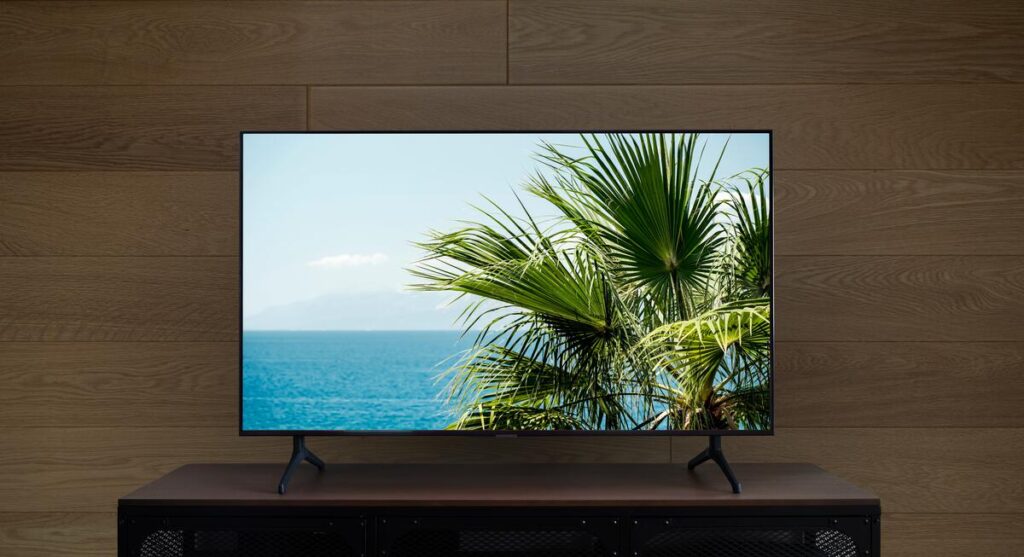Do OLED TVs Have A Backlight? (Explained For Beginners)
Disclosure: Tech Parasol is supported by its readers. When you purchase through links on our site, we may earn an affiliate commission. Thank you.
- OLED TVs do not have a backlight
- The pixels in an OLED TV are self-emissive
- OLED TVs do not get as bright as LED/LCD TVs
OLED TVs are best known for their unrivaled picture quality. But they do use a fundamentally different type of display technology than that used in LED/LCD TVs.
One question that gets asked often is whether OLED TVs have a backlight to illuminate the display like traditional LED/LCD TVs do.
So that’s the question we’re going to answer in this post.
Let’s get to it.
Here’s whether OLED TVs have a backlight:
OLED TVs do not have a backlight or an LCD layer. Instead, the pixels in an OLED TV are powered by individual Organic Light Emitting Diodes (OLEDs) which produce light by themselves. As a result, OLED TVs can also be manufactured to be lighter and thinner, making them easy to wall mount.

How do OLED TVs light up?
If OLED TVs don’t have a backlight, then how do they light up?
Well, the OLEDs themselves are made up of organic compounds (hence the name). When a voltage is applied to one of these OLEDs, the current flows through the device and produces light.
Light is produced when electrons meet “holes” (the absence of an electron) in the “emissive layer” (one of the many layers in an OLED).
When an electron meets a “hole”, energy is released in the form of photons – light, in other words.
Although light is only released in a fraction of a second, if current continues to flow through the device, light continues to be produced.
The light produced is then passed through a color refiner to produce the images that you see on screen.
Because there is no backlight in an OLED TV, they can be made much thinner and are much lighter.
They can also be turned off individually, which gives an OLED TV an infinite contrast ratio.
But we’ll come on to this in the following section – the issue of brightness.
Are OLED TVs as bright as an LED TV?
In a word, no. OLED TVs do not get as bright as LED TVs and their peak brightness, measured in nits, is significantly less.
The reason for this is that the OLEDs themselves emit light by themselves and they don’t have an external light source like those in LED TVs.
The LEDs in traditional backlights are relatively large and powerful, and so can get extremely bright.
Full-array LED panels have lots of LEDs, so they can get even brighter than the most common edge-lit displays.
This is where the LEDs are positioned along the edges of the display.
Also, with the addition of Quantum Dot technology (QLED), the LEDs in backlights can be made even smaller, without a reduction in brightness.
As such, LED TVs literally outshine OLED TVs, particularly in bright rooms.
But OLED TVs outperform LED TVs in dark rooms. This is because they have the ability to completely switch off.
This produces unrivaled black levels which means that the difference in luminance between the darkest blacks and the brightest whites at any given time is said to be infinite.
This is known as the “contrast ratio”.
Higher contrast radios contribute to a better and more realistic picture overall.
So you’ll get brighter highlights and darker shadows and all the shades in between.
Are OLED TVs better than full-array backlighting?
OLED TVs have a better picture quality than current full-array, back-lit LED TVs, because OLEDs can be controlled individually and can be turned off completely.
Full-array LED TVs are of course much better than edge-lit displays because there are more LEDs which are grouped into blocks or zones rather than around the edges.
This gives a more even spread of light across the screen.
Each zone controls the brightness for one portion of the screen and can be controlled invidvicidally. Each zone can also be completely turned off which produces true blacks.
The action of turning these zones on and off is called “local dimming”.
This local dimming allows a full-array backlit TV to produce deeper shadows, brighter highlights and therefore a much better contrast ratio than traditional edge-lit TVs.
But they still can’t match the contrast ratios of OLED TVs, yet.
I say “yet”, because there is a new technology just around the corner which may rival OLED.
This technology is called micro-LED.
Micro-LED TVs use lots of microscopic LEDs to produce an image and don’t use LCD panels.
This technology should not be confused with mini-LED displays that also use lots of mini-LEDs. These displays are still fundamentally LCD displays.
Each pixel in an micro-LED TV has three of these microscopic LEDs: one red, one green and one blue. The colors are combined to produce almost any color available.
Micro-LED technology promises to rival the contrast ratios that OLED TVs currently have the monopoly on.
But also, they promise to be capable of getting much brighter than OLED TVs (up to 5,000 nits), which is one of the downsides to OLED TVs at the moment.
But this technology is very new and is very expensive. Micro LED TVs are also only available in huge sizes.
But it’s definitely a technology to keep an eye out for.
Can you turn the brightness up and down on an OLED TV?
You can turn the brightness up and down on an OLED TV.
But by increasing the brightness of an OLED TV to the max for long periods of time, the overall lifespan of the OLEDS will be reduced.
It will also take the OLEDs longer to totally power off.
But it is worth cranking up the brightness when watching HDR movies and TV shows for maximum effect.
LG OLED TVs also have a feature called “AI Brightness”.
This setting, when enabled in the settings, allows a sensor within the TV to detect the brightness of the ambient lighting.
It then adjusts the brightness of the TV accordingly.
Do OLED TVs have backlight bleed?
OLED TVs do not suffer from backlight bleed because they don’t have a backlight like LED/LCD TVs do.
In LED TVs, backlight bleed is when the light from the backlight leaks around the edges of the TV causing the lighting to be uneven across the screen.
This problem is more prevalent in edge-lit TVs and unfortunately, there’s not much that can be done to fix it.
Do OLED TVs burn out?
OLED TVs do not burn out, in fact, according to LG and The Korea Times, the lifespan of an OLED is at 100,000 hours.
This figure was quoted around 2016, so I’d expect that value to be even higher now.
If you break down that figure of 100,000 hours, then it’s the equivalent of watching 10 hours of TV for 30 years!
Do OLED TVs get dimmer over time?
OLED TVs do get dimmer over time, but it will take around 100,000 hours.
Manufacturers use the half-life of an LED to denote their lifespan. So the 100,000 hours quoted above by The Korea Times, is the length of time it takes the OLEDs to reach their half-life.
The half-life of an OLED is the time it takes to reach 50% of its original brightness.
Sources
How OLEDs (organic LEDs) work – Explain that Stuff
Comparing the Peak Brightness of OLED and QD Displays
OLED vs. LED: Which Kind of TV Display Is Better? | Digital Trends
‘Thorough inspection brings perfection to LG’s OLED TV’

Robert Anderson
Robert Anderson, the founder of Tech Parasol, had a keen interest in tech from a very young age. He studied Electronic Engineering at University and then went on to become a Software Developer. He launched Tech Parasol in 2021 to share his knowledge with the aim of making tech easier to understand for everyone.

